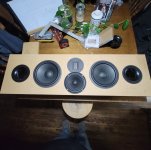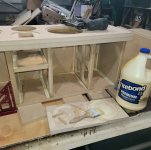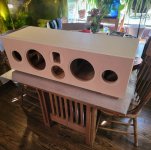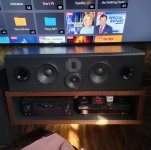Im building a center channel and have some measurments questions. The drivers im using are:
Tweeter: HiVi RT1.3WE
Mid: 5" SB 13PFCR25-8
Woofers: (2x) 8" Silverflute W20RC38-04
Target crossover points are:
300mhz/3000mhz. (80Htz crossover to sub)
Tools im using:
Dats V3
UMM6 usb mike
REW
Xsim
Question:
When making the FRD and ZMA files for the two woofers do i measure them indiviualy or wired in parallel like they will be used?
If measured together are they still represented in xSim with one driver?
-Travis
Tweeter: HiVi RT1.3WE
Mid: 5" SB 13PFCR25-8
Woofers: (2x) 8" Silverflute W20RC38-04
Target crossover points are:
300mhz/3000mhz. (80Htz crossover to sub)
Tools im using:
Dats V3
UMM6 usb mike
REW
Xsim
Question:
When making the FRD and ZMA files for the two woofers do i measure them indiviualy or wired in parallel like they will be used?
If measured together are they still represented in xSim with one driver?
-Travis
Attachments
I don't know the details of the software.
What I would do is wire them in series for 8 ohms, and measure them that way. Then estimate a 2nd order filter for them at 300hz. Lower would be better, but with everything, there are compromises. Low x-over points will make the response increase in the bass range. Can you fix that with EQ from the AVR?
Will these be placed close to the screen, or other reflective surfaces?
What I would do is wire them in series for 8 ohms, and measure them that way. Then estimate a 2nd order filter for them at 300hz. Lower would be better, but with everything, there are compromises. Low x-over points will make the response increase in the bass range. Can you fix that with EQ from the AVR?
Will these be placed close to the screen, or other reflective surfaces?
See here, specifically page 9 for NF measurements with dual woofer.When making the FRD and ZMA files for the two woofers do i measure them indiviualy or wired in parallel like they will be used?
https://kimmosaunisto.net/Software/VituixCAD/VituixCAD_Measurement_REW.pdf
Question:
When making the FRD and ZMA files for the two woofers do i measure them indiviualy or wired in parallel like they will be used?
If measured together are they still represented in xSim with one driver?
You could do combined output acoustic and combined impedance, and put it in xsim as one driver.
You could do separate acoustic and impedance measurements and put it in xsim as 2 drivers.
A combined representation would fail to capture some of the spatial aspects, but xsim is aimed at on-axis only, so not really a deal breaker IMO. VituixCad is aimed at also simming off-axis, so in that package it would be better to do the separate representation.
Since it's two woofers a fair distance apart, this brings up some questions of near-field vs far-field measurements. I think you'd want to take your acoustic measurement from a ways back in order to capture things correctly. Since your intended low-pass is lowish for the woofers, prob no issue. You might look into this if you haven't considered it already.
You mention having a USB mic, are you aware of how to capture phase / time of flight? USB has non-fixed latency, so some care is required.
EDIT: Now that I look at your pictures, it appears that your woofers are sharing a volume? In that case, I think you probably can't measure them individually, as failing to drive one speaker would impact both acoustic and impedance measurements.
Last edited:
I dont know how to capture phase / time of flight. I havent heard about it. What should i look for?
I will measure them together then, is 1 meter enough?
I will measure them together then, is 1 meter enough?
The issue is that USB has some latency, and it changes as the device opens / closes streams. Since the physical offset of drivers relative to each other is important to their relative phase, and different measurements can have different delays from USB, this can screw things up.I dont know how to capture phase / time of flight. I havent heard about it. What should i look for?
One way to deal with it is to use REW to make an acoustic timing reference. This is to set a small speaker at a constant location during your measurement session, and REW sends a signal to that, then to the main device. Then the delay of your main device is relative to the acoustic reference. I haven't done this, so I won't go into it, I'd probably get it all wrong. There is info in the REW documentation about it, and you can find more online.
Another way it to zero your time in REW according to the impulse and essentially have no time-of-flight in your measurements. Then you measure each set of drivers. Then you measure e.g. wf and mid together, and get the interference pattern for them. Then you twiddle the delay on the driver in xsim until you can have both drivers playing in xsim produce a curve that looks like the REW measurement of both.
I've switched away from the USB mic. I use a 2 channel USB sound card, with output to amp and input from mic on 1 channel set, and a loopback path (output wired straight to input) on the other channel. Then the electrical loopback provides the timing reference.
This is a fairly common issue, buncha people have written / made videos about it.
I will measure them together then, is 1 meter enough?
You want to get into the far field for these drivers. Normally it would be the diameter of 1 driver, but you're running 2 so it's the distance from one to the other... You can research near-field and far-field on line. But probably you want to catch baffle effects like the baffle step and possibly diffraction, so you should go for far field relative to the longest dimension of the baffle. I've heard different multipliers for this length, 3x, 5x, 10x. This can become troublesome for large cabinets. I usually go 3-5x.
The single vs double driver issues are covered in the paper linked in post #5.
You'll see +6dB over the individual woofer responses on the tweeter axis, regardless of the separation. (Moving back for the baffle still applies, of course.)Since it's two woofers a fair distance apart, this brings up some questions of near-field vs far-field measurements. I think you'd want to take your acoustic measurement from a ways back in order to capture things correctly. Since your intended low-pass is lowish for the woofers, prob no issue. You might look into this if you haven't considered it already.
Last edited:
That will apply to vituixcad for the purpose of simulating lobing.The single vs double driver issues are covered in the paper linked in post #5.
The down side to measuring them separately, is that you can better measure woofer lobing with polar measurements than simulating it, and that only works if you also use an alternate method to calculate or measure crossover lobing.
Last edited:
- Home
- Loudspeakers
- Multi-Way
- 3way Center channel measuring




